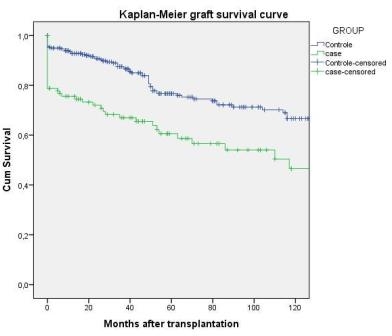Kidney Retransplantation in the Ipsilateral Iliac Fossa; a Surgical Challenge
1Transplant Surgery, Erasmus Medical Center, Rotterdam, Netherlands
2Nephrology, Erasmus Medical Center, Rotterdam, Netherlands.
Meeting: 2015 American Transplant Congress
Abstract number: C227
Keywords: Kidney transplantation, Outcome, Post-operative complications, Retransplantation
Session Information
Session Name: Poster Session C: Surgical Issues/Ureteral Complications
Session Type: Poster Session
Date: Monday, May 4, 2015
Session Time: 5:30pm-6:30pm
 Presentation Time: 5:30pm-6:30pm
Presentation Time: 5:30pm-6:30pm
Location: Exhibit Hall E
Introduction: The aim of this study is to review the surgical outcome of kidney retransplantation in the ipsilateral iliac fossa in comparison to first kidney transplants. Methods: Our hospital database was screened for retransplantations between 1995-2013. Each patient that underwent a kidney retransplantation in the ipsilateral iliac fossa was matched with 3 patients with a first kidney transplantation. Matching was based on recipient gender and age, year of transplantation and type of donor (deceased vs. living). Demographic characteristics, surgical outcome, surgical re-interventions and long-term graft survival were compared. Follow-up was until July 2014 for all cases and controls.
Results: We identified 99 patients that received a retransplantation in the ipsilateral iliac fossa. The study group had a significantly higher current and historic highest PRA, P<0.001. There was significantly more blood loss and longer operating time in the retransplantation group. The number of vascular complications was higher in the study group, respectively 8% vs 2%. Surgical re-interventions due to bleeding, urological complications or otherwise did not differ significantly between the study and the control group. The number of graft nephrectomies within 1 year was significantly higher in the study group: 16 patients (16%) vs. 14 patients (5%) with a first transplant. The Kaplan-Meier graft survival curve shows that the majority of graft failures in the study group were within the first month after transplantation and due to cellular rejection or thrombotic events. After one year, graft survival curves were almost parallel. The graft survival rates at 1 year and 3, 5 and 10 years were 76%, 67%, 61% and 47% in the study group vs. 94%, 88%, 77% and 67% in the control group.  Conclusion: Kidney retransplantation in the ipsilateral iliac fossa is surgically challenging and associated with more vascular complications and graft loss within the first year after transplantation. Patients should be informed about these complications during informed consent.
Conclusion: Kidney retransplantation in the ipsilateral iliac fossa is surgically challenging and associated with more vascular complications and graft loss within the first year after transplantation. Patients should be informed about these complications during informed consent.
To cite this abstract in AMA style:
Ooms L, Roodnat J, Dor F, Tran K, Kimenai D, IJzermans J, Terkivatan T. Kidney Retransplantation in the Ipsilateral Iliac Fossa; a Surgical Challenge [abstract]. Am J Transplant. 2015; 15 (suppl 3). https://atcmeetingabstracts.com/abstract/kidney-retransplantation-in-the-ipsilateral-iliac-fossa-a-surgical-challenge/. Accessed January 7, 2026.« Back to 2015 American Transplant Congress
